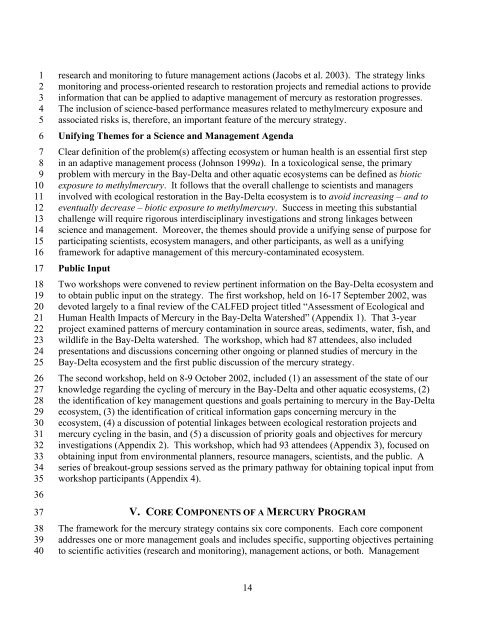Mercury Strategy for the Bay-Delta Ecosystem - CALFED Bay-Delta ...
Mercury Strategy for the Bay-Delta Ecosystem - CALFED Bay-Delta ...
Mercury Strategy for the Bay-Delta Ecosystem - CALFED Bay-Delta ...
You also want an ePaper? Increase the reach of your titles
YUMPU automatically turns print PDFs into web optimized ePapers that Google loves.
1<br />
2<br />
3<br />
4<br />
5<br />
6<br />
7<br />
8<br />
9<br />
10<br />
11<br />
12<br />
13<br />
14<br />
15<br />
16<br />
17<br />
18<br />
19<br />
20<br />
21<br />
22<br />
23<br />
24<br />
25<br />
26<br />
27<br />
28<br />
29<br />
30<br />
31<br />
32<br />
33<br />
34<br />
35<br />
36<br />
37<br />
38<br />
39<br />
40<br />
research and monitoring to future management actions (Jacobs et al. 2003). The strategy links<br />
monitoring and process-oriented research to restoration projects and remedial actions to provide<br />
in<strong>for</strong>mation that can be applied to adaptive management of mercury as restoration progresses.<br />
The inclusion of science-based per<strong>for</strong>mance measures related to methylmercury exposure and<br />
associated risks is, <strong>the</strong>re<strong>for</strong>e, an important feature of <strong>the</strong> mercury strategy.<br />
Unifying Themes <strong>for</strong> a Science and Management Agenda<br />
Clear definition of <strong>the</strong> problem(s) affecting ecosystem or human health is an essential first step<br />
in an adaptive management process (Johnson 1999a). In a toxicological sense, <strong>the</strong> primary<br />
problem with mercury in <strong>the</strong> <strong>Bay</strong>-<strong>Delta</strong> and o<strong>the</strong>r aquatic ecosystems can be defined as biotic<br />
exposure to methylmercury. It follows that <strong>the</strong> overall challenge to scientists and managers<br />
involved with ecological restoration in <strong>the</strong> <strong>Bay</strong>-<strong>Delta</strong> ecosystem is to avoid increasing – and to<br />
eventually decrease – biotic exposure to methylmercury. Success in meeting this substantial<br />
challenge will require rigorous interdisciplinary investigations and strong linkages between<br />
science and management. Moreover, <strong>the</strong> <strong>the</strong>mes should provide a unifying sense of purpose <strong>for</strong><br />
participating scientists, ecosystem managers, and o<strong>the</strong>r participants, as well as a unifying<br />
framework <strong>for</strong> adaptive management of this mercury-contaminated ecosystem.<br />
Public Input<br />
Two workshops were convened to review pertinent in<strong>for</strong>mation on <strong>the</strong> <strong>Bay</strong>-<strong>Delta</strong> ecosystem and<br />
to obtain public input on <strong>the</strong> strategy. The first workshop, held on 16-17 September 2002, was<br />
devoted largely to a final review of <strong>the</strong> <strong>CALFED</strong> project titled “Assessment of Ecological and<br />
Human Health Impacts of <strong>Mercury</strong> in <strong>the</strong> <strong>Bay</strong>-<strong>Delta</strong> Watershed” (Appendix 1). That 3-year<br />
project examined patterns of mercury contamination in source areas, sediments, water, fish, and<br />
wildlife in <strong>the</strong> <strong>Bay</strong>-<strong>Delta</strong> watershed. The workshop, which had 87 attendees, also included<br />
presentations and discussions concerning o<strong>the</strong>r ongoing or planned studies of mercury in <strong>the</strong><br />
<strong>Bay</strong>-<strong>Delta</strong> ecosystem and <strong>the</strong> first public discussion of <strong>the</strong> mercury strategy.<br />
The second workshop, held on 8-9 October 2002, included (1) an assessment of <strong>the</strong> state of our<br />
knowledge regarding <strong>the</strong> cycling of mercury in <strong>the</strong> <strong>Bay</strong>-<strong>Delta</strong> and o<strong>the</strong>r aquatic ecosystems, (2)<br />
<strong>the</strong> identification of key management questions and goals pertaining to mercury in <strong>the</strong> <strong>Bay</strong>-<strong>Delta</strong><br />
ecosystem, (3) <strong>the</strong> identification of critical in<strong>for</strong>mation gaps concerning mercury in <strong>the</strong><br />
ecosystem, (4) a discussion of potential linkages between ecological restoration projects and<br />
mercury cycling in <strong>the</strong> basin, and (5) a discussion of priority goals and objectives <strong>for</strong> mercury<br />
investigations (Appendix 2). This workshop, which had 93 attendees (Appendix 3), focused on<br />
obtaining input from environmental planners, resource managers, scientists, and <strong>the</strong> public. A<br />
series of breakout-group sessions served as <strong>the</strong> primary pathway <strong>for</strong> obtaining topical input from<br />
workshop participants (Appendix 4).<br />
V. CORE COMPONENTS OF A MERCURY PROGRAM<br />
The framework <strong>for</strong> <strong>the</strong> mercury strategy contains six core components. Each core component<br />
addresses one or more management goals and includes specific, supporting objectives pertaining<br />
to scientific activities (research and monitoring), management actions, or both. Management<br />
14

















